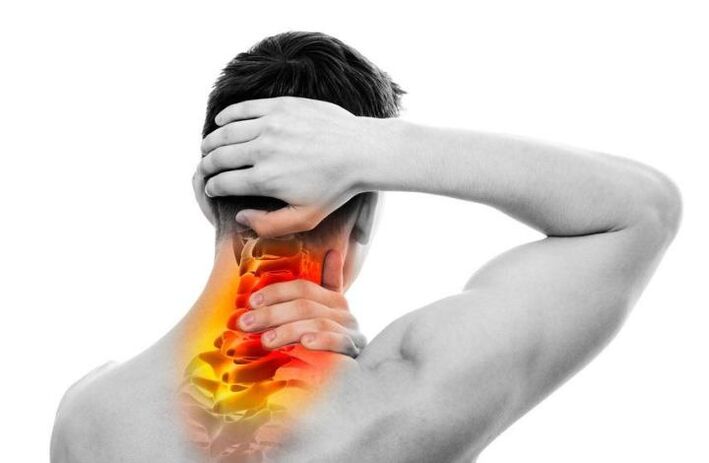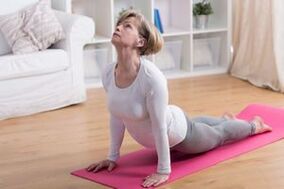Osteochondrosis is a disease when the vertebrae are damaged, which causes compression of the intervertebral disc. This leads to pain due to pinched nerve fibers. Narrowed blood flow leads to disruption of internal organs. When this disease appears in the cervical spine, it affects the blood supply to the soft tissues of the head and brain, disrupting the passage of nerve impulses to the central nervous system.
Why does cervical osteochondrosis occur?

This condition can be caused by:
- Hereditary tendency to a decrease in the number of intervertebral discs.
- Back, neck or limb injuries.
- Skeletal muscle weakness.
- Difficult working conditions.
- Improper or excessive weight training.
- Contagious disease.
- Shoes that cause a change in gait, which increases the load on the spine.
- Unbalanced diet.
- Genetic disease.
Most of the causes that trigger cervical osteochondrosis and its symptoms can be prevented.It is necessary to create suitable conditions for work, as well as choose physical activities that strengthen the muscles that support the spine. But this is not always possible to do in time, because one rarely thinks of a problem that does not yet exist. Therefore, you need to know what are the most common signs of osteochondrosis of the neck:
- reduced range of motion;
- constant or throbbing pain;
- vertebral fracture when moving the head;
- headaches that do not go away with medication;
- numbness of one or more limbs;
- trembling of limbs or involuntary muscle contractions;
- dizziness, loss of movement coordination or consciousness;
- tinnitus (ringing or ringing in the ears);
- problems remembering or using learned information;
- memory loss;
- problems with the work of the rectal sphincter and bladder neck.
Each neck osteochondrosis is unique, and affects different body functions, so some symptoms may not be present. But patients always have difficulty turning, pain, and when the situation worsens, headaches and dizziness.
How to determine the disease at home

Pain from osteochondrosis can be both pulsating, short-term, and long and always bothers a person. When the neck is affected, the discomfort extends to the shoulder girdle, and is most often located on the side of the working arm. In this case, pain can occur in the neck and between the shoulder blades, and affect the entire arm.
The complexity of the diagnosis arises from the fact that discomfort can change over time, due to changes in body position, stress, or other reasons. Therefore, the first signs of osteochondrosis can be associated with overstrain or muscle tension. But over time, attacks of pain and stiffness become more frequent and intense, which requires determining the cause and starting treatment.
It is quite difficult to independently determine the cause of pain in cervical osteochondrosis at home.In order for the suspicion of osteochondrosis to be justified, it is necessary to exclude other options. Often, pain is caused by muscle tension, incorrect posture while sleeping or at work. Therefore, it is necessary to correct this condition to understand whether it is the main source of unpleasant sensations.
If the problem with the neck persists, then this is a serious symptom that can talk about both osteochondrosis and other diseases, such as:
- tumors;
- infection;
- nerve root compression.
Therefore, you need to see a doctor and take an x-ray. This will tell you if there are injuries or other signs of outside influence.
After it is known that the neck is affected by osteochondrosis, regardless of the method of obtaining information, it is still not clear what causes the disease. You can independently determine only violations of working conditions, power loads and injuries. The rest of the disease can be recognized only after passing a complete examination - this is necessary, because infections affecting the spine, or other similar disorders pose a serious danger to health and life.
How to treat osteochondrosis with drugs and folk remedies
After making a diagnosis, you should use the treatment plan that the doctor will make, or create it yourself. When choosing the point, it is important to emphasize an integrated approach in the choice of means and systematic implementation of all recommendations.
What to do with osteochondrosis of the cervical spine:
- apply for medications;
- use folk remedies;
- conduct physiotherapy;
- change lifestyle to eliminate the cause of disease.
Medicines include:
- Oral and topical preparations that relieve pain and reduce inflammation, but do not contain steroid ingredients.
- Pain relievers that contain corticosteroids.
- Relax the muscles.
- Antidepressants (if the work of the central nervous system is depressed, which causes a violation of the emotional background).
- Anti-inflammatory ointment.
- Plaster for pain relief.
Folk methods include:
- Herbal decoctions and infusions used orally. The effect of the fund depends on the raw material used for it. These can be both general strengthening compounds that fill the body with useful substances, as well as painkillers or anti-inflammatory drugs.
- Compressing - most often heating, to relieve neck muscle spasms and allow the spine to return to its original position.
- Rubbing - rubbing folk remedies into the skin, often combined with massage or self-massage. It has different directions of action, but is most often used to relieve pain, warm up and relax muscles.

Physiotherapy includes:
- Massage performed by medical professionals - medical procedures have a beneficial effect on the spine and back muscles. In the event of a violation in the neck, you should not use the services of a massage therapist who specializes in conducting only relaxation sessions.
- Self-massage - actions performed correctly help warm the neck muscles, relieve spasms and restore blood circulation in the cervical and shoulder areas.
- Improving working conditions, choosing suitable furniture to maintain correct posture, and in sedentary work - frequent breaks during physical movement.
- Increase the number of walks, using shoes with shock-absorbing soles. Walking helps produce the correct load on the back, especially in the lumbar region, as the clamps on the skeletal muscles are removed, and the spine returns to its anatomically correct position.
- Perform a warm-up in the morning, including both exercises for the neck and shoulder girdle, and affect the rest of the body. In this case, all movements are performed only with their own weight, or in rare cases, light dumbbells are allowed.
- Sauna or bath - a visit to the steam room with a course of 10-12 times can significantly reduce tension in the back muscles and activate the body's metabolic processes.
- A procedure prescribed by a doctor and carried out with the help of special equipment (electrophoresis, etc. ).
In addition, swimming in the pool is a good way to maintain optimal muscle tone, relieve spasms and eliminate atrophy. This must be done continuously, and should be started as soon as the inflammation stops. The first visit should be given a moderate load on the shoulder girdle, after which it should be increased gradually until swimming becomes a full exercise.
Subject to the doctor's recommendation, remission occurs quickly enough if the disease does not turn into a moderate or severe form. But it is important to remember that even the complete disappearance of symptoms is not a sign of a cure.















































